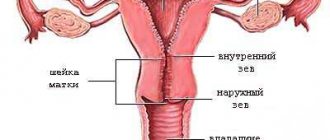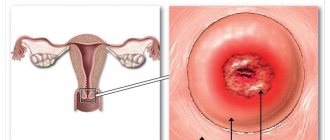Despite its relatively small size, the cervix is a rather complexly organized organ, and its pathology is very diverse. The inside of the cervical (cervical) canal is lined with cells of single-layer columnar epithelium. It has many depressions - glands that produce mucus, the properties of which vary depending on the age of the woman and the phase of the menstrual cycle. Outside (from the vagina), the cervix is covered with a completely different layer of cells—stratified squamous non-keratinizing epithelium. It moves to the vaginal vault and lines the vaginal cavity from the inside. It has no glands and changes less during the menstrual cycle. The border between these two types of epithelium is most often located in the area of the external uterine pharynx (entrance to the cervical canal of the uterus) and is called the transformation zone (Fig. 1).
Figure 1. Zonal anatomy of the cervix.
More than 90% of cervical neoplasia (precancerous condition) and cancerous lesions occur in the transformation zone.
What is “cervical erosion”?
The term "erosion" refers to a tissue defect. For example, we commonly call such a defect on the skin “abrasion.” True erosion of the cervix is extremely rare and is of a traumatic or radiation nature. For some reason, in Russian-speaking usage, in the old fashioned way, this term refers to any change in the cervix that is visible to the eye and has a brighter color than the usual mucous membrane. This is an outdated, incorrect term. It was used by gynecologists in the pre-colposcopic and pre-histological era, when any change in the cervix was regarded on the basis of examination as erosion and it was IMPOSSIBLE to make a more accurate diagnosis.
What lies behind the brightly colored “spot” in the area of the external uterine pharynx, which is found in every fourth woman of reproductive age, and which is called “congenital erosion”? As already mentioned, the border of two types of cellular lining of the cervix (single-layer cylindrical and stratified squamous epithelium) is most often located in the area of the external uterine pharynx (entrance to the cervical canal) and is called the transformation zone (Fig. 1). But this border is not fixed throughout a woman’s life. In all girls, before the onset of puberty, the border runs outward from the external pharynx, and then gradually shifts inward. In postmenopausal (menopausal) women, the transformation zone is located approximately at the border of the middle and lower third of the cervical canal (Fig. 2).
Figure 2. Cervical transformation zone.
During reproductive age, due to individual variations, about a quarter of young women have an outward displacement of the transformation zone. Since single-layer cylindrical epithelium has a brighter color and a more “juicy” appearance, during a gynecological examination in the speculum it has a characteristic appearance, which doctors used to mistake for erosion. The correct name for this phenomenon is ectopia (or ectropion ), which literally translates as “located outside” (Fig. 3).
Figure 3. Localization of cervical ectopia.
The appearance of cervical ectopia is shown in Fig. 4.
Figure 4. Cervical ectopia.
Opening of the internal os during normal pregnancy
With a physiological course, the cervix begins to prepare for childbirth, starting at 32-34 weeks. During this period, it becomes softer at the edges and more often comes into tone, which leads to softening and thinning of its lower section. The part on top, on the contrary, becomes denser. These changes lead to the fact that the child begins to gradually descend and, with his weight, provoke its further opening. This process proceeds quite slowly and takes about a month, intensifying a few days before birth.
The following symptoms are signs of labor:
- the fundus of the uterus begins to descend. This takes about 3 weeks immediately before the contractions themselves. This process is a consequence of the fact that the fetus is pressed against the pelvis. A woman can notice this by the fact that it becomes easier for her to breathe;
- the baby's head puts pressure on the bladder and intestines, which leads to more frequent trips to the toilet and constipation;
- the uterus becomes more sensitive and reacts by becoming harder at the slightest irritation (sudden movements of the woman or fetus, when touching the abdomen);
- the woman feels preparatory contractions, which are felt less frequently and shorter than the real ones;
- the neck becomes plastic and soft.
Vaginal examination of the cervix is routinely performed at 20, 28, 32 and 36 weeks. If there are any problems, the inspection is carried out more often. The opening of the internal os at 36-38 weeks of pregnancy normally indicates the completion of preparation for childbirth. At the moment, there has already been a partial replacement of muscle tissue with connective tissue, which is able to stretch to a greater extent during childbirth. The doctor sees this by the fact that the cervix has become looser and its shortening leads to a gaping of the cervical canal. If a woman is preparing to become a mother for the first time, then the external pharynx allows only the tip of a finger to enter; in multiparous women - 1 finger. The cervix begins to open from the internal os. If the birth is the first, then the canal in its shape resembles a truncated cone with the base at the top. Further, the pressure of the fetus promotes stretching of the external pharynx. During repeated births, this process is simpler and takes less time, due to the fact that the external pharynx is already open by 1 finger. In this case, the outer and inner pharynx open almost simultaneously.
Is “congenital” ectopia a pathology?
No. This is an individual feature. With age, most likely, the transformation zone will shift to the cervical canal. But even if this does not happen, nothing needs to be done. Previously, “cauterization of erosion” was performed for most women whose ectopia persisted after childbirth. Now this tactic is considered incorrect, since women are exposed to an unreasonable risk of even a small surgical intervention, which has more complications and side effects than even a very long-term existence of ectopia can bring. Therefore, today, treatment of ectopia without concomitant pathology is carried out only in the case of an extremely large area, especially with the transition to the vaginal vaults (this condition is called adenosis), and sometimes with increased secretion of glands, the ducts of which open on the surface of the ectopia. In a word, ectopia is not a disease or even a risk factor for the disease, and therefore is only subject to observation once a year for cytological control.
What are Nabothian cysts (Ovula Nabothii)?
In the transformation zone, the flat epithelium gradually “creeps” onto the columnar epithelium, “closing” the ectopia. However, the excretory ducts of the glands may become closed, and the mucus they produce accumulates in the form of small cysts. These cysts can be multiple and range in size from 1 mm to 2 cm. Small cysts do not require any treatment. Only large (severely deforming the cervix) and continuing to grow cysts may require opening and evacuation of the contents. But this happens extremely rarely.
Diseases of the cervix include the following:
- Inflammation of the cervical canal (endocervicitis).
- Cicatricial post-traumatic (postpartum or postoperative) deformity.
- Human papillomavirus infection (HPV), including cervical condylomas.
- Cervical intraepithelial neoplasia (CIN) (Other names: dysplasia, dyskeratosis, squamous intraepithelial formation (SIL)) and cervical intraepithelial glandular neoplasia (CIGN).
- Cervical cancer: squamous cell carcinoma or adenocarcinoma.
- Endometriosis of the cervix.
- Polyps and fibroids of the cervical canal.
Read about diagnostic methods (colposcopy, targeted biopsy, cytological and histological studies) and treatment of precancerous diseases of the cervix (laser coagulation, cryodestruction, diathermoexcision, conization of the cervix) in the sections diagnostics, treatment and services.
- Inflammation of the cervical canal - endocervicitis . Most often it is caused by sexually transmitted infections (chlamydia, mycoplasma, gonococci) or nonspecific infections (streptococcus, staphylococcus, E. coli, corynebacteria, enterococcus, etc.). In the first case, infection occurs through sexual contact. The second group of microorganisms enters the cervix most often by lymphogenous (through lymphatic vessels) or contact (from the rectum) route; however, sexual intercourse is not necessary for their development, but can contribute to inflammation. Other provoking factors may be some benign diseases of the cervix (see below), cicatricial deformation of the cervix, weakening of general and local immunity. Endocervicitis is manifested by profuse mucous leucorrhoea, sometimes with an unpleasant odor. Endocervicitis can be one of the causes of miscarriage and premature birth. The disease can be suspected already during a gynecological examination: a large amount of mucus is released from the cervical canal, the transformation zone has a bright pink color. To diagnose the infection that caused the process, the following tests are taken: a smear for the degree of purity, culture for flora and sensitivity to antibiotics, testing for the presence of chlamydia, mycoplasma and ureaplasma (by PCR or culture), sometimes culture on special media to isolate trichomonas, fungus genus candida, gonococcus. Treatment for endocervicitis depends on what infection is causing it.
- Deformation of the cervix occurs due to traumatic childbirth or surgical interventions on the cervix. During labor, the cervix shortens, flattens, and then dilates to a diameter of 10 cm, allowing the fetal head to pass through the mother's birth canal. Sometimes, during the passage of the head, the cervix ruptures. This is facilitated by the following factors: rapid and rapid labor, weakness of labor with early ineffective pushing, inappropriate behavior of the woman in labor during pushing, which is often observed against the background of fatigue and painful contractions, the application of “high” obstetric forceps, a large fetus (weighing more than 4000 grams). ), previous operations on the cervix, including cervical excision, diathermocoagulation of ectopia, etc., ruptures in previous births. Most often, ruptures occur on the sides of the neck (at 3 and 9 o'clock). They can be of several degrees in depth. At the most severe degree, the ruptures reach the vaginal fornix and spread to the body of the uterus. After childbirth, the obstetrician examines the cervix “in the speculum” and, if ruptures are detected, closes them with absorbable sutures. Unfortunately, not all ruptures are diagnosed and carefully sutured. In such cases, the cervix after childbirth is formed defective - the cervical canal often remains gaping, and the cervix itself can take on the most bizarre shapes. If a woman is not planning a pregnancy, then nothing may bother her, and she will only find out about the presence of scars and deformities during the next gynecological examination. However, problems may arise during the next pregnancy - most often, spontaneous abortions (miscarriages) and premature births. There are extremely many reasons for spontaneous abortions, and cervical pathology is not the most common of them. However, cervical insufficiency can be suspected if the miscarriage occurs more than 16 weeks, begins with rupture of amniotic fluid, and there is a history of traumatic birth or cervical surgery. Diagnosis includes a visual examination in a gynecological chair, and, if necessary, cervicohysterography (X-ray examination with the introduction of a contrast agent into the lumen of the cervical canal and the uterine cavity). Treatment is required if a woman suffers from miscarriage due to severe deformation of the cervix. In such cases, surgical treatment is performed - cervical plastic surgery (tracheloplasty). If a cervical deformity is detected during pregnancy in the presence of signs of a threatening miscarriage, a special circular suture is placed on the cervix in order to preserve the pregnancy, designed to compensate for the lost mechanical function of the cervix. This suture usually remains until full term pregnancy. It is removed either on the eve of the expected birth, or in the event of the onset of labor.
- Papillomavirus infection (HPV) , including exophytic condylomas of the cervix.
 In short, you should know that: 1) the development of exophytic condylomas on the surface of the cervix, most often caused by papillomavirus type 6, leads to changes in the mucosa, which can be characterized as a mild degree of dysplasia (see point 4). 2) They themselves do not lead to the development of cancer and precancerous conditions of the cervix. 3) Small condylomas often undergo spontaneous regression (disappear on their own). 4) Oncogenic serotypes of HPV viruses (16, 18, 35, 39, 45) significantly increase the risk of developing severe dysplasia and cervical cancer. Moreover, they are the main cause of the development of these diseases. 5) Oncogenic types of viruses do not cause the development of exophytic condylomas. They are integrated into the genome of epithelial cells and change their genetic properties, promoting gradual cancerous degeneration. 6) Exophytic condylomas of large sizes, as a rule, must be removed (for example, using electrocoagulation, laser, podophyllotoxin preparations, etc.). 7) To date, there are no systemic medications that can reliably cure the papilloma virus. Detection of long-term persistence (preservation in the body) of oncogenic type papilloma viruses is the main risk factor for the development of severe degrees of dysplasia and cervical cancer, therefore, in this case, a particularly thorough and frequent examination of the cervix is required in order to detect the disease in time and adequately treat it.
In short, you should know that: 1) the development of exophytic condylomas on the surface of the cervix, most often caused by papillomavirus type 6, leads to changes in the mucosa, which can be characterized as a mild degree of dysplasia (see point 4). 2) They themselves do not lead to the development of cancer and precancerous conditions of the cervix. 3) Small condylomas often undergo spontaneous regression (disappear on their own). 4) Oncogenic serotypes of HPV viruses (16, 18, 35, 39, 45) significantly increase the risk of developing severe dysplasia and cervical cancer. Moreover, they are the main cause of the development of these diseases. 5) Oncogenic types of viruses do not cause the development of exophytic condylomas. They are integrated into the genome of epithelial cells and change their genetic properties, promoting gradual cancerous degeneration. 6) Exophytic condylomas of large sizes, as a rule, must be removed (for example, using electrocoagulation, laser, podophyllotoxin preparations, etc.). 7) To date, there are no systemic medications that can reliably cure the papilloma virus. Detection of long-term persistence (preservation in the body) of oncogenic type papilloma viruses is the main risk factor for the development of severe degrees of dysplasia and cervical cancer, therefore, in this case, a particularly thorough and frequent examination of the cervix is required in order to detect the disease in time and adequately treat it. - Cervical intraepithelial neoplasia (dysplasia) . This term (CIN) is used to refer to disorders of the maturation and structure of stratified squamous epithelium. Changes are assessed by cytological examination of cell scrapings from the surface of the neck and/or by histological examination of biopsy material. This pathology is associated with impaired cellular differentiation and maturation. There are three degrees of dysplasia: CIN I, CIN II, CIN III. With mild dysplasia (CIN I), cell maturation is impaired in the lower third of the epithelial layer. The top two thirds look typical. With the second and third degrees of dysplasia (CIN II, CIN III), cell maturation is impaired, respectively, in 2/3 or throughout the entire thickness of the epithelium. The next most severe cellular and tissue changes are carcinoma in situ, which translates as cancer “in place,” that is, within the epithelial layer, without growing into the underlying tissue of the cervix.
In turn, CIGN is an analogue of CIN, but refers to columnar epithelium. CIGN is judged by cellular atypia of the epithelial layer. Accordingly, adenocarcinoma in situ is distinguished as the most severe dysplasia. Cells of altered tissue (both squamous and cylindrical epithelium) look atypical, which is confirmed by cytological examination of scrapings from the surface of the cervix (Papanicolau smear). In them, the nucleus is enlarged, it has a lighter color, and the content of cytoplasm in the cell is reduced. In addition to the changes described, blood vessels also acquire a special structure: they come close to the surface, arranged in the form of loops, spirals and other elaborate shapes. This helps distinguish healthy tissue from pathological tissue during colposcopic examination of the cervix.
Types of cervicitis
There are:
- Along the course - acute and chronic cervicitis.
- By localization - exo- and endocervicitis. Exocervicitis is an inflammation of the vaginal cervix. Endocervicitis is an inflammation of the internal canal of the cervix, the cervical canal.
- According to the prevalence of the process - focal (local) and diffuse (widespread).
- According to the causative agent - specific and nonspecific cervicitis. Specific cervicitis is provoked by sexually transmitted infections, the causative agents of which are gonococci, chlamydia, and mycoplasma. Nonspecific cervicitis is caused by conditionally pathogenic microorganisms, such as gardnerella, streptococci, enterococci, Escherichia coli, Pseudomonas aeruginosa, and Candida fungi. Viral cervicitis caused by the genital herpes virus or human papillomavirus (HPV) is also possible.
What can happen to dysplasia if it is not treated?
57% of CIN I spontaneously regress (“go away on their own”), 32% persist as CIN I for a long time, 11% progress to CIN II, CIN III, and only 0.5% progress to invasive carcinoma. Unlike mild dysplasia, CIN III turns into invasive cancer in 12% of cases within 2 years, and regresses quite rarely.
Is it possible to suspect the presence of CIN before visiting a gynecologist?
As a rule, no. CIN and CIGN have virtually no clinical manifestations. Therefore, you need to visit your doctor regularly (at least once a year) , even if there is absolutely nothing bothering you. The appearance of bloody discharge during sexual intercourse deserves special attention. If the cervix bleeds, this can be a very serious symptom, indicating a pronounced pathological process, including cancer. Other causes of bleeding after sexual intercourse may be inflammation, atrophy of the vaginal mucosa (for example, in postmenopausal women), and pathology of the uterine body. In women taking microdose hormonal contraceptives, this can be observed, among other things, due to thinning of the endometrium against the background of weak hormonal stimulation. All these reasons are temporary, harmless and easily removable. But, to exclude the most serious of them - cervical diseases, all women with spotting after sexual intercourse are advised to immediately visit a gynecologist.
Cervical cancer . This is a dangerous malignant disease. Every year, about 400,000 are detected worldwide. new cases of cervical cancer, of which about 200,000 are fatal. Cervical cancer ranks third among cancer pathologies in women, second only to breast and uterine cancer. Squamous cell carcinoma develops from squamous epithelium, and adenocarcinoma, which has a high degree of malignancy (tendency to rapid growth and metastasis), develops from cylindrical epithelium.
The average age for the onset of squamous cell carcinoma is 46 years, for adenocarcinoma - 35 years. Often, malignant pathology of the cervix in women at risk develops even earlier - at the age of 24 years. According to the degree of invasion (germination of layers located under the epithelium), cancer is divided into carcinoma in situ, minimally invasive, and invasive cancer. Invasive cancer has 4 stages, depending on invasion into neighboring organs, involvement of regional lymph nodes and the presence of distant metastases (bones, liver, brain). The 5-year survival rate for the first stage is 85%, with 4 - 5%. Given the questionable prognosis and complex combination treatment of invasive cancer, the primary focus of public health in developed countries is on the early diagnosis of precancerous lesions and carcinoma in situ. In particular, in the USA, since 1960, it has now been possible to reduce mortality from cervical cancer by 87%, thanks to an established screening system (see the services section). If you want to protect yourself from developing incurable stages of cervical cancer, visit your gynecologist annually and undergo a special examination!
Symptoms of cervicitis
In women with cercivitis, there may be no severe symptoms at all, or the manifestations may be minor - cloudy mucous discharge from the genital tract. Often the disease is detected during a preventive examination by a gynecologist. This is typical for the erased chronic course of the disease.
Signs of acute cervicitis and exacerbation of chronic:
- mucopurulent leucorrhoea (vaginal discharge),
- bloody discharge (with the development of erosions),
- pain in the lower abdomen,
- discomfort during urination or sexual intercourse,
- itching and burning in the vagina.
In general, symptoms vary depending on the causative agent of the disease.
Cervicitis may be asymptomatic or have vague signs. In this case, you can find out about the development of the disease only during an examination by a gynecologist. Make an appointment with a doctor to identify hidden pathologies and restore women's health.
Make an appointment with a gynecologist
Who is at risk for developing dysplasia and cervical cancer?
- Carriers of HPV oncogenic serotypes (16, 18, 31, 45, and about a dozen intermediate-risk viruses)
- Long-term persistence of oncogenic types of virus (more than 2 years)
- High “viral load”, i.e. a large number of serotypes and their high concentration in tissues at the same time.
- Early onset of sexual activity
- Many sexual partners throughout life
- Smoking
Endometriosis of the cervix . Genital endometriosis is an extremely common disease in women of reproductive age. The most common locations of the lesion are the body of the uterus, ovaries, pelvic peritoneum, and uterosacral ligaments. The cervix accounts for only an extremely small percentage of endometrioid heterotopias. The cause of endometriotic lesions of the cervix is diathermocoagulation of ectopia, damage during surgical abortion, childbirth. On the relatively deep wound surface, pieces of endometrial tissue, released during the next menstruation, attach and “take root.” Cervical endometriosis usually manifests itself in the form of bleeding on the eve of menstruation. Diagnosis is carried out on the basis of a visual gynecological examination and colposcopy. Treatment is surgical and is necessary only for large heterotopias and in the presence of clinical manifestations. To remove heterotopias, their laser vaporization is used.
Polyps and fibroids of the cervical canal . The reasons for the appearance of polyps are not completely clear. Their structure is characterized by a central connecting stalk, covered with either stratified squamous or columnar epithelium. Most often, polyps are an accidental finding during a regular gynecological examination. If they are large, they can bleed easily. Polyps are a benign disease. However, sometimes cancer (especially adenocarcinoma) can have the appearance of a polyp. Such a polyp, as a rule, has an unevenly colored bumpy surface and bleeds easily. The presence of a polyp is an indication for its removal, followed by diagnostic curettage of the cervical canal and uterine cavity. Histological examination of the obtained material is important. Often, at the same time as a polyp of the cervical canal, a polyp or endometrial hyperplasia is detected.
Fibroids (myomatous nodes) of the cervix are less common than in the body of the uterus (see section “uterine fibroids”). They can also be subserous, intramural and submucosal. The presence of cervical fibroids in the vast majority of cases is an indication for surgical treatment. In the case of submucosal nodes, they are removed (with a scalpel or an electrocoagulator). Large intramural and subserous nodes quickly disrupt the anatomy and function of adjacent organs (bladder, ureters, rectum), and therefore are also an indication for one or another operation (conservative myomectomy, hysterectomy). The latter can be performed using either abdominal or vaginal access.
Treatment of cervicitis at the Yauza Clinical Hospital
Specialists at the Yauza Clinical Hospital provide comprehensive treatment for cervicitis (inflammation of the cervix) and associated pathological processes.
Conservative.
In case of acute cervicitis, the doctor prescribes the patient treatment with antibacterial drugs, taking into account the sensitivity of the identified pathogen to antibiotics, or antiviral therapy, as well as anti-inflammatory drugs. Both general pharmacotherapy and local treatment of cervicitis are carried out - suppositories with antibacterial, antifungal and other agents. If the infectious nature of the disease is revealed, treatment of cervicitis in women must be carried out simultaneously with treatment of her sexual partner. 2-3 weeks after the end of the course of treatment for cervicitis, a control examination using laboratory tests is carried out.
Surgical.
If one of the causes of chronic cervicitis is cicatricial deformation of the cervix, after stopping the inflammation and eliminating the infection, the woman can undergo surgical (laser or radio wave) correction.
Cervicitis is a disease that can be avoided by following simple prevention rules. Sign up for a consultation with a gynecologist at the Yauza clinic. During your appointment, you will receive comprehensive information about the prevention of cervicitis and other diseases of the genitourinary system.
Make an appointment
You can see prices for services
Where to go for diagnosis and treatment of cervical diseases?
The medical institution to which you should contact must have an adequate diagnostic base. All types of cytological and histological studies should be available here. A highly qualified pathologist (histologist) must be well versed in all types of epithelial lesions, from the most minor and benign, to precancerous (such as CIN) and malignant. The institution must have PCR diagnostics available (including for detecting papillomavirus infection and its typing), there must be all the necessary instruments for high-quality collection of materials for research (special disposable brushes, spatulas), there must be special standard instruments for cervical biopsy uterus, there must be electrosurgical equipment for conization of the cervix. The gynecologist must have a high-quality colposcope and be fully proficient in the techniques and methods of colposcopy. Doctors at a clinic specializing in the treatment of cervical diseases must have access to and master methods of excision and destruction of affected tissue (electrocoagulation and excision, laser coagulation or evaporation, cryodestruction). If necessary, doctors must also perform surgical excision (“cold knife”) of the affected tissue with the application of cosmetic sutures. Ideally, the medical institution you choose should have sufficient administrative and computer facilities to track and monitor patients at high risk for developing cervical cancer. Remember that the widespread introduction in developed Western countries of preventive cytological examinations of cervical smears stained with Papanicolaou, as well as other components of the treatment and preventive program for cervical diseases, has reduced the incidence of cervical cancer by 87%. THIS IS THE BASIS OF THE SIGNIFICANT INCREASE (BY 15 YEARS) IN THE AVERAGE LIFE EXPECTATION OF WOMEN IN WESTERN EUROPEAN COUNTRIES, JAPAN AND THE USA IN RECENT YEARS.






